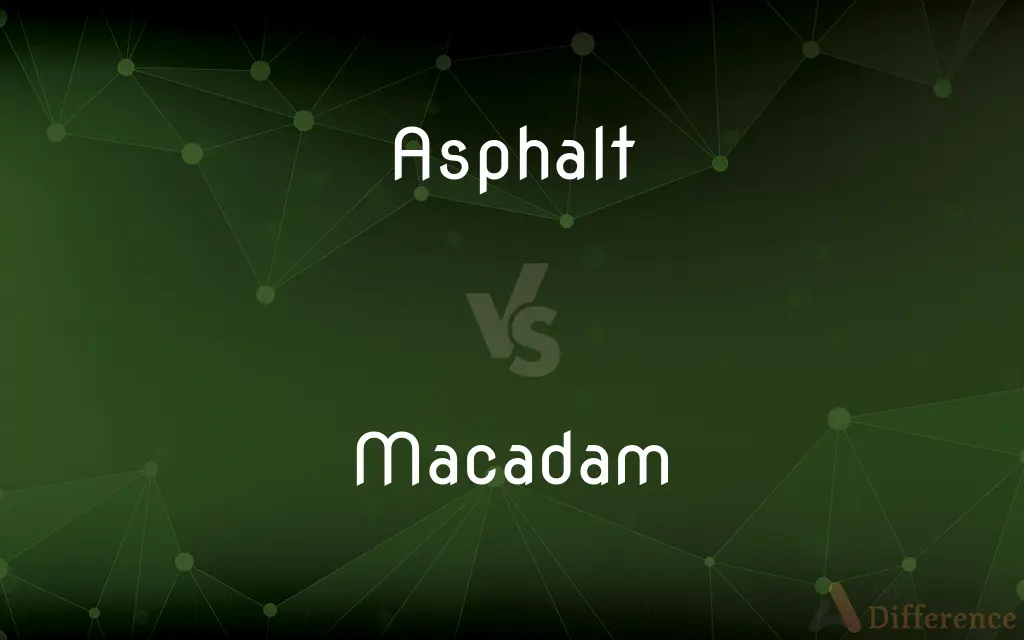Asphalt vs. Macadam — What's the Difference?
By Tayyaba Rehman — Updated on May 29, 2024
Asphalt is a sticky, black liquid used for road surfacing, while macadam is a type of road construction using layers of crushed stone bound with tar.

Difference Between Asphalt and Macadam
Table of Contents
ADVERTISEMENT
Key Differences
Asphalt is a black, sticky substance that's derived from crude oil. It is used as a binder in road construction, binding the aggregate particles together to form a strong, cohesive material. On the other hand, macadam is a method of road construction where crushed stone layers are compacted and then bound together using tar or bitumen. Macadam was a precursor to the modern asphalt roadway.
When considering their origins, asphalt naturally occurs in certain areas and can also be manufactured in refineries by distilling crude oil. Macadam, named after its inventor John McAdam, doesn't refer to a material itself but to a process where stones of varying sizes were used to create durable roads, long before asphalt became popular.
Asphalt roads today are made by mixing hot asphalt with aggregate (like sand or gravel) and then compacting this mixture while it's still hot. This creates a smooth, durable surface. Macadam roads, historically, were made by placing and compacting layers of crushed stone, with the smallest stones on top. Over time, tar or bitumen was added on top to seal and bind the road, leading to what we now call "tar-bound macadam" or simply "tarmac."
In terms of usage, while asphalt is predominantly used today because of its durability and ease of application, macadam roads can still be found in some areas, especially in older roads or in places where the benefits of its porous nature (like drainage) are desired.
It's important to understand that while all macadam roads could be considered a type of asphalt road when tar is added, not all asphalt roads are macadam roads. The distinction lies in the method of construction and materials used.
ADVERTISEMENT
Comparison Chart
Origin
Derived from crude oil
Named after John McAdam
Material/Process
Sticky, black liquid combined with aggregate
Layers of crushed stone bound with tar
Popularity
Predominantly used today
Less common, mainly older roads
Surface Appearance
Smooth and dense
More porous, allowing for drainage
Evolution
A primary method of road construction
Precursor to modern asphalt roads
Compare with Definitions
Asphalt
A black, viscous liquid used primarily for road surfacing.
The city laid fresh asphalt on the main street last week.
Macadam
A method of road construction using compacted layers of small stones.
The old country road was built using macadam technique.
Asphalt
Asphalt, also known as bitumen (UK: , US: ), is a sticky, black, highly viscous liquid or semi-solid form of petroleum. It may be found in natural deposits or may be a refined product, and is classed as a pitch.
Macadam
Roads made from crushed or ground stones, bound together with tar.
The macadam road provided good drainage during heavy rains.
Asphalt
A mixture of bitumen with sand or gravel, used for surfacing roads and for roofing.
Workers spread the asphalt mix evenly across the highway.
Macadam
Macadam is a type of road construction, pioneered by Scottish engineer John Loudon McAdam around 1820, in which single-sized crushed stone layers of small angular stones are placed in shallow lifts and compacted thoroughly. A binding layer of stone dust (crushed stone from the original material) may form; it may also, after rolling, be covered with a binder to keep dust and stones together.
Asphalt
A naturally occurring or refined pitch that hardens upon exposure.
Natural asphalt deposits were discovered in the region.
Macadam
A type of road surface where stones of varying sizes are compacted for strength.
Macadam roads were common in the 19th century.
Asphalt
A mixture of dark bituminous pitch with sand or gravel, used for surfacing roads, flooring, roofing, etc.
Macadam
A predecessor to modern asphalt roads, using stone and sometimes tar.
Many macadam roads were eventually paved over with asphalt for added durability.
Asphalt
A waterproofing agent used in various products and applications.
The asphalt sealant protected the roof from leaks.
Macadam
A technique emphasizing stone size and layering for road longevity.
The macadam design ensured fewer ruts and potholes over time.
Asphalt
(transitive) To pave with asphalt.
Macadam
Paved with macadam.
Asphalt
Cover with tar or asphalt;
Asphalt the driveway
Macadam
Broken stone used in macadamized roadways
Asphalt
A dark bituminous substance that's soluble in carbon disulfide.
They extracted asphalt from the oil sands for further processing.
Macadam
A paved surface having compressed layers of broken rocks held together with tar
Asphalt
Surface with asphalt.
Macadam
Broken stone of even size, bound with tar or bitumen and used in successively compacted layers for surfacing roads and paths.
Asphalt
See bitumen.
Macadam
Pavement made of layers of compacted broken stone, now usually bound with asphalt.
Asphalt
A mixture of bitumen with crushed stone gravel or sand, used for paving or roofing.
Macadam
(uncountable) The surface of a road consisting of layers of crushed stone (usually tar-coated for modern traffic).
Asphalt
To pave or coat with asphalt.
Macadam
Any road or street.
Asphalt
Ellipsis of asphalt concrete, a hard ground covering used for roads and walkways.
Macadam
(transitive) To cover or surface with macadam.
Asphalt
Mineral pitch, Jews' pitch, or compact native bitumen. It is brittle, of a black or brown color and high luster on a surface of fracture; it melts and burns when heated, leaving no residue. It occurs on the surface and shores of the Dead Sea, which is therefore called Asphaltites, or the Asphaltic Lake. It is found also in many parts of Asia, Europe, and America. See Bitumen.
Macadam
The broken stone used in macadamized roadways.
Asphalt
To cover with asphalt; as, to asphalt a roof; asphalted streets.
Macadam
A paved surface formed of compressed layers of broken rocks held together with tar.
Asphalt
A dark bituminous substance found in natural beds and as residue from petroleum distillation; consists mainly of hydrocarbons
Asphalt
A sticky, black and highly viscous liquid or semi-solid, composed almost entirely of bitumen, that is present in most crude petroleums and in some natural deposits.
Asphalt
A composition of bitumen, pitch, lime, and gravel, used for forming pavements, and as a water-proof cement for bridges, roofs, etc.; asphaltic cement. Artificial asphalt is prepared from coal tar, lime, sand, etc.
Asphalt
Mixed asphalt and crushed gravel or sand; used especially for paving but also for roofing
Common Curiosities
What is asphalt?
Asphalt is a black, sticky substance derived from crude oil, used primarily for road construction and roofing.
Why is asphalt more popular today?
Asphalt offers a smooth, durable, and water-resistant surface, making it the preferred choice for modern roadways and infrastructure.
Was macadam a precursor to asphalt roads?
Yes, macadam roads, when bound with tar, evolved into what many refer to today as asphalt roads.
How is asphalt different from macadam?
While asphalt is a material derived from crude oil and used as a binder, macadam refers to a road construction technique using compacted stone layers, sometimes bound with tar.
What is macadam?
Macadam is a method of road construction that involves compacting layers of crushed stone and sometimes binding them with tar.
Is macadam still used today?
While less common than asphalt, macadam techniques can still be found in older roads or in areas where its porous nature is beneficial.
Do all roads with asphalt qualify as macadam?
No, while all macadam roads with tar can be considered a type of asphalt road, not all asphalt roads are made using the macadam technique.
Can asphalt be naturally occurring?
Yes, asphalt can be found naturally in certain areas and is also manufactured in refineries by distilling crude oil.
How did macadam get its name?
Macadam is named after John McAdam, an engineer who developed the technique in the early 19th century.
Which provides better drainage, asphalt or macadam?
Macadam roads, being more porous, typically offer better drainage than dense asphalt surfaces.
Share Your Discovery

Previous Comparison
Gears vs. Sprocket
Next Comparison
Triennially vs. TriannuallyAuthor Spotlight
Written by
Tayyaba RehmanTayyaba Rehman is a distinguished writer, currently serving as a primary contributor to askdifference.com. As a researcher in semantics and etymology, Tayyaba's passion for the complexity of languages and their distinctions has found a perfect home on the platform. Tayyaba delves into the intricacies of language, distinguishing between commonly confused words and phrases, thereby providing clarity for readers worldwide.













































